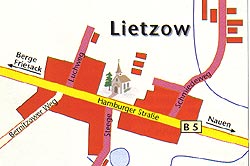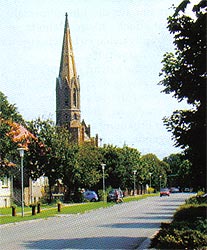












The village Lietzow is situated directly at the B5 between Nauen and Berge. It is presumed that the region has been a settlement area for a very long time. But the village itself was only recorded in 1317 for the first time. It was called Lytzowe in 1335 and in the year 1442 was named Liezowe as it is called still today. As the name suggests the village goes back to a Slavic village. Lietzow is a typical ribbon-built village. The history of the village is not especially spectacular. But there is one building that is highly architectonical interesting.
When one visits the church one doesn't suspects anything special. But it is a neo-gothic brick building from the year 1863 that was planed and built by August Stüler, a student of the famous Karl Friedrich Schinkel.

The building and its interior up to the colouring have luckily been preserved in large parts in its original state. Despite the church's desolate state it is a very important building under the monumental protection viewpoint because it was a real sensation in its time. The especially important parts of the church like window elements including tracery, clock faces and staircase with stair bracket, floor boards and some interior items were done in concrete at the time a highly modern building material. One has to realise that cement was only invented in England in 1727 and ferroconcrete in France four years after the church was built. At this time some innovative master builder tried the new architectonical, creative and constructive possibilities that were offered by this building material. That is why the church is also an important technical design historical document apart from its architectonical balance.
The pictures + contents of this page were kindly made available by Stadtmagazinverlag AS GmbH. Photo: Stadtmagazinverlag AS